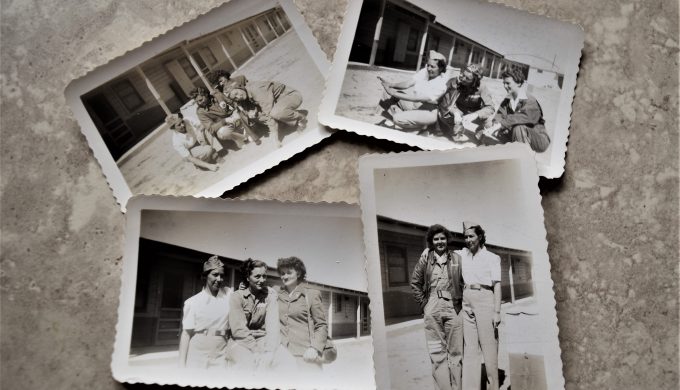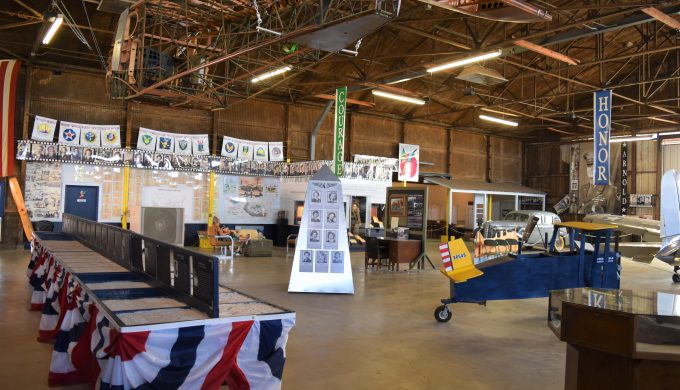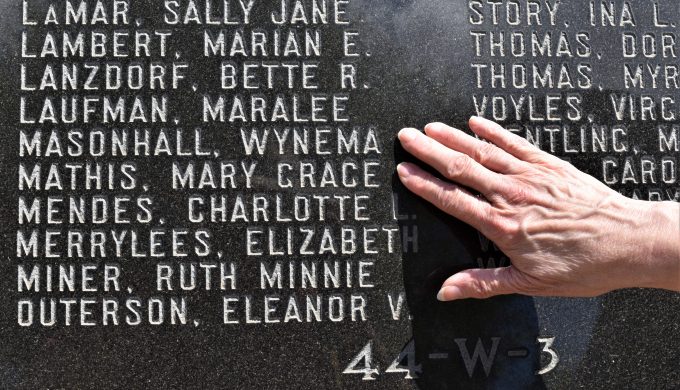In July 1943, air campaigns were taking a heavy toll on Allied pilots in the European and Pacific theaters. The U.S. Army Air Force needed every available male pilot on the front lines—and that summer, my mother-in-law joined the war effort in Sweetwater, Texas.
On May 8, we observe the 75th anniversary of V-E (Victory in Europe) Day. The pioneering women who trained at Avenger Field, particularly one family member I never got to meet, inspired this story.
Photo: John Spaulding. Mary Grace Mathis waits for a training flight, possibly to try some of her favorite acrobatics.
A twice-divorced mother of a young son (my wife’s half-brother), Mary Grace Mathis was an accomplished pilot—and fiercely patriotic. The freedom of leaving earth behind (and some of her problems) inspired her to train for her pilot’s license in the late 1930s. She took lessons from an old barnstormer (acrobatic pilot), the head of Hudson’s Flying Club at Love Field, Dallas, where she soloed after completing her training. She took to Hudson’s style of acrobatic flying immediately, and it remained her favorite type of flying. She excelled in the more difficult maneuvers and was featured with other women fliers in a 1941 article in the Dallas Morning News, when she was one of only 3,000 female pilots in the U.S.
When the U.S. entered World War II, Mary Grace discovered the ideal outlet for her patriotism and love of flying; the Women Airforce Service Pilots (WASP), formed in 1942, were accepting applications. She met the minimum height requirement, 5’4,” and she had flown more than the required number of hours since getting her license.
Photo: John Spaulding. Life at Avenger Field with other pilots. Mary Grace Mathis is shown in the trainee’s dress outfit of white shirt and khaki pants.
Unfortunately, there was no stunt flying allowed in the WASP program, “and we had to fly those old Army trainers. It was like driving a bus, or maybe a tank, when you wanted to be driving a sports car,” my wife recalls her mom saying. But none of that mattered—even the strict military discipline and training (identical to male pilots, with the exception of combat roles). Above all, they were pilots contributing to the war effort. They ferried planes throughout the continental U.S., they towed targets, and they trained pilots. Mary Grace was one of 25,000 who applied and 1,830 who were accepted. It was only her own mother’s fatal heart attack that brought her home early before completing the program in 1944.
My wife and I met Carol Cain and Ann Haub, Vice President and Museum Archivist, respectively, at the National WASP Museum of World War II in Sweetwater. We presented the museum last fall with artifacts and photos of Mary Grace’s time in the WASP, just steps away from where she ate, slept, and trained to serve.
Photo: John Spaulding. Marilyn Mathis Spaulding (right) wearing a replica of the WASP wings her mother would have received at graduation, after presenting memorabilia to Ann Haub (left), museum archivist.
Touring the museum provides a look into the world of the WASP program. WASP Director Jacqueline Cochran, considered the best pilot of her era, held all of the top female distance, speed, and altitude records until she died in 1980. A single exhibit tells her story. Nancy Love, commander of the previously established Women Air Ferrying Service (WAFS), is also recognized as an integral part of the WASP program’s success. A large video screen provides some of the sights, sounds, and music the WASP would have known as their routine. A reproduced barracks speaks to their spartan daily life, positioned next to a vintage PT-19A aircraft used by WASP during their training. An eight-foot obelisk memorializes the 38 women who died while training or on duty after graduation. Most striking are the handprints in concrete, made by several dozen WASP alumnae who returned over the years. Fewer than 30 of the original 1,074 graduates are still alive. The youngest is 96.
Photo: John Spaulding. A portion of the inside of the museum. Note the handprints of returning WASP alumnae to the left, and the silver obelisk dedicated to the memory of the 38 pilots who lost their lives during the program’s existence.
They flew all the aircraft the men flew, including some considered too dangerous to fly. The ranking officers could be heard embarrassing the men into the cockpit by saying, “If that ‘girl’ flew that plane, why can’t you?” Carol Cain also recalls, “The U.S. was manufacturing planes in Niagara, New York, for Russia’s use in the war. The WASP would fly them to Montana, so the men could ferry them to Alaska, and then Russia’s pilots would ferry them back to their own country. So, you might be surprised in the Midwest to look up and see a plane flying overhead with Russian markings.” And people might have been even more surprised that it was a woman flying it.
The WASP’s struggle for recognition as veterans is well documented, as they were considered a civilian outfit, governed under the U.S. Civil Service, not the military. In 1977, Congress made the long-overdue decision to bestow military honors on all of the program graduates, living or deceased. In 2010, President Obama bestowed the Congressional Gold Medal for Service, now displayed at the museum.
Photo: John Spaulding. Marilyn finds her mother’s name listed under 44-W-2, which would have been Mary Grace Mathis’ graduation class in 1944.
To complete our journey, we traveled a short distance outdoors from the museum to view a granite wall, inscribed with names of trainees and graduates. My wife ran her fingers across her mother’s name, reflecting with pride and gratitude on Mary Grace’s service.
A statue of a WASP in flying gear faces the tribute wall, gazing toward the sky. The statue inscription reads, “We live in the wind and the sand . . . and our eyes are on the stars.” By demonstrating their flying acumen in a harsh environment, these dedicated patriots changed the perception and future role of women in aviation.
Mary Grace’s WASP memorabilia have now returned home. She has earned the wings of recognition that eluded her at Avenger Field. All of us benefit from her legacy, as we too still gaze upward with our eyes on the stars.
Visit their website at www.waspmuseum.org







